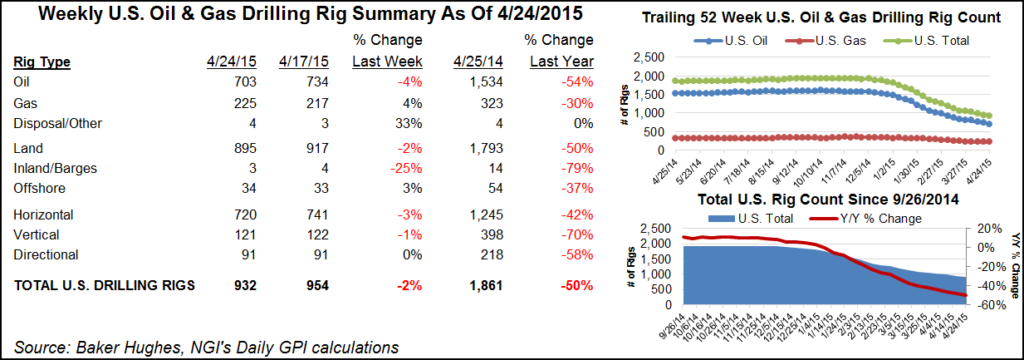Overall U.S. Rigs Decline, But NatGas Adds Two
While the unconventional rig count for the week ending June 19 showed a small gain in the number of oil and natural gas rigs on the job (see related story), the overall U.S. rig picture still showed a two rig decline to 857, according to Baker Hughes data.

In shaking down the data, U.S. oil rigs declined by four to 631 (down 59% from one year ago), while natural gas rigs jumped two to 223 (down 28% from one year ago). The overall 857 rigs in operation represents a 54% decline from the same week a year ago.
Much has been made of the cutbacks made by the E&P sector due to low oil and natural gas commodity prices. While steep job cuts in the oilfields of Texas and North Dakota have been hard to miss in recent months, the Appalachian Basin has not been immune, but the downturn’s effects have been harder to gauge due to the region’s prolific production and low finding and development costs (see related story).
However, there have also been recent, albeit few signs of investment and rigs returning to specific plays. Just this week, Clayton Williams Energy Inc. announced it is raising its capital expenditure plans this year and resuming drilling in Texas in the Permian Basin and the Upper Eagle Ford Shale during the third quarter (see Shale Daily, June 18).
For the week ending June 19, offshore oil and gas rigs declined by two to 27, but that count could see two more rigs added in the near future. Royal Dutch Shell plc said this past week that its plans to explore the Chukchi Sea offshore Alaska this summer are accelerating as federal regulators signed off on several critical permits (see Daily GPI, June 16). The National Oceanic and Atmospheric Administration (NOAA) last Monday approved Shell’s request for an incidental harassment authorization. NOAA acknowledged that planned drilling and associated activities would disturb some marine mammals that live in the area or migrate through it.
Earlier this month the U.S. Environmental Protection Agency (EPA) approved two permits to discharge wastewater from the two contracted drilling rigs, the Transocean Polar Pioneer and the Noble Discoverer. The EPA permits allow water-based drilling fluids, cuttings from inside the well and wastewater produced on board to be discharged from the well. Still outstanding are a few permit approvals from the Department of Interior’s Bureau of Safety and Environmental Enforcement and the U.S. Fish and Wildlife Service.
© 2024 Natural Gas Intelligence. All rights reserved.
ISSN © 1532-1231 | ISSN © 2577-9877 | ISSN © 1532-1266 |
